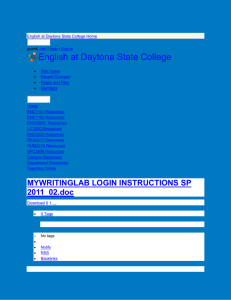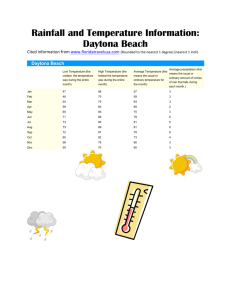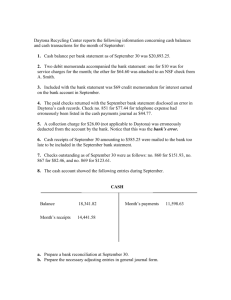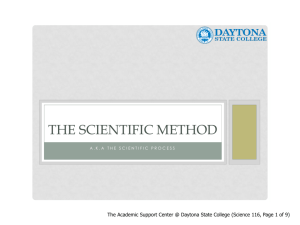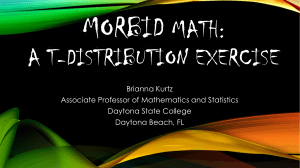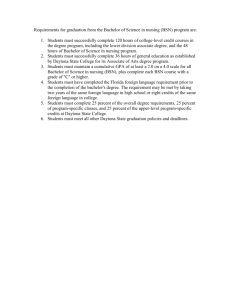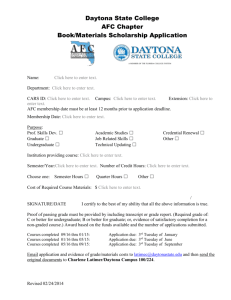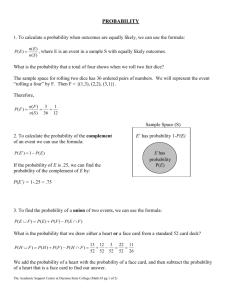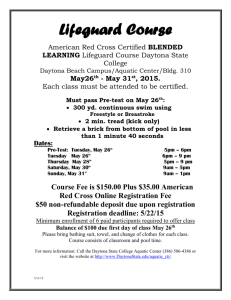Anatomy and Physiology II
advertisement
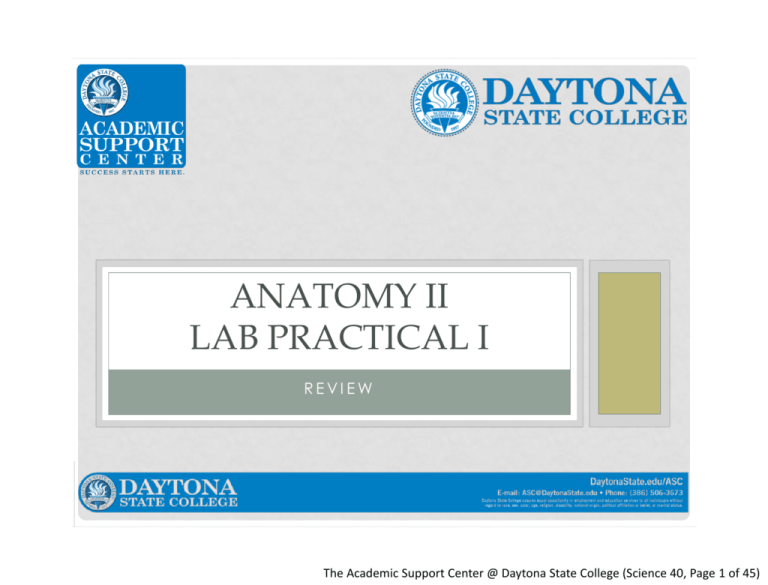
ANATOMY II LAB PRACTICAL I REVIEW The Academic Support Center @ Daytona State College (Science 40, Page 1 of 45) Endocrine System What is the Endocrine System? A method of communication between cells in the body wherein glands produce hormones, which affect distant target organs. What is an endocrine gland? A gland that produces hormones A gland that releases hormones into the blood What is a hormone? A chemical message in the blood What is a target organ? An organ or gland that receives hormonal stimulation The Academic Support Center @ Daytona State College (Science 40, Page 2 of 45) Endocrine System What are the different types of hormones? Steroid Monoamine Peptide/Glycoprotein If hormones travel in the blood and come into contact with all tissues, why don’t they affect all tissues? They require a receptor either on the cell surface (polypeptide) or inside the cell (steroid) The Academic Support Center @ Daytona State College (Science 40, Page 3 of 45) Endocrine System What are the endocrine organs? 1 - Pineal Gland 2 - Hypothalamus 3 - Anterior Pituitary (Adenohypophysis) 4 - Posterior Pituitary (Neurohypophysis) 5 - Thyroid 6 - Parathyroid 7 - Thymus 8 - Adrenal Glands 9 - Kidneys (EPO) 10 - Pancreas 11 - Ovaries 12 - Testes 1 6 2 3&4 5 7 9 8 10 11 12 The Academic Support Center @ Daytona State College (Science 40, Page 4 of 45) Endocrine System What is the hypophyseal portal system? Portal System that connects the hypothalamus to the anterior pituitary What is a portal system? Any veins that lead to another capillary bed instead of going directly to the heart The Academic Support Center @ Daytona State College (Science 40, Page 5 of 45) Hormones of the Pineal Gland What hormones does the pineal gland make? Melatonin Serotonin What does the pineal gland regulate? Circadian Rhythms and Biological processes such as puberty The Academic Support Center @ Daytona State College (Science 40, Page 6 of 45) Hormones of the Hypothalamus What are the hypothalamic hormones? GHRH – Growth Hormone Releasing Hormone Somatostatin(GHIH) – Growth Hormone Inhibiting Hormone PRH – Prolactin Releasing Hormone PIH (Dopamine) – Prolactin Inhibiting Hormone GnRH – Gonadotropin Releasing Hormone CRH – Corticotropin Releasing Hormone TRH – Thyrotropin Releasing Hormone The Academic Support Center @ Daytona State College (Science 40, Page 7 of 45) Hormones of the Anterior Pituitary What are the hormones made by the anterior pituitary? GH – Growth Hormone PRL – Prolactin Gonadotropins FSH – Follicle Stimulating Hormone LH – Luteinizing Hormone ACTH – Adrenocorticotropic Hormone TSH – Thyroid Stimulating Hormone The Academic Support Center @ Daytona State College (Science 40, Page 8 of 45) Hormones of the Posterior Pituitary What are the hormones of the Posterior Pituitary? OT – Oxytocin ADH – Antidiuretic Hormone Where are the hormones of the posterior pituitary made? Hypothalamic Nuclei Supraoptic and Paraventricular The Academic Support Center @ Daytona State College (Science 40, Page 9 of 45) Hormones of the Thyroid and Parathyroid Glands What hormones are produced by the thyroid gland? T3 and T4 Calcitonin What hormones are produced by the parathyroid glands? PTH – Parathyroid Hormone, calcitriol The Academic Support Center @ Daytona State College (Science 40, Page 10 of 45) Hormones of the Thymus What hormones are produced by the thymus? Thymosin and Thymopoietin The Academic Support Center @ Daytona State College (Science 40, Page 11 of 45) Hormones of the Adrenal Glands What are the two layers of the adrenal glands? Adrenal Cortex Adrenal Medulla What hormones are made by the Adrenal Cortex? Mineralocorticoids Glucocorticoids Gonadocorticoids What hormones are made by the adrenal medulla? Epinephrine Norepinephrine The Academic Support Center @ Daytona State College (Science 40, Page 12 of 45) Hormones of the Kidneys and Pancreas What hormone is made by the kidneys? What hormones are made by the Pancreas and what cells are they made by? EPO – Erythropoietin Insulin – Beta Cells Glucagon – Alpha Cells What two types of tissue are in the pancreas? Pancreatic Islets (Islets of Langerhans) Acini Cells The Academic Support Center @ Daytona State College (Science 40, Page 13 of 45) Hormones of the Ovaries What hormones are made by the ovaries? Progesterone Estrogen The Academic Support Center @ Daytona State College (Science 40, Page 14 of 45) Hormones of the Testes What hormones are made by the testes? Testosterone The Academic Support Center @ Daytona State College (Science 40, Page 15 of 45) Endocrine System Be able to identify the following: Thyroid Thymus Pancreas Adrenal Glands Ovaries Testes The Academic Support Center @ Daytona State College (Science 40, Page 16 of 45) Cat Dissection – Endocrine System 3 4 1 2 o o o o 1 – Thyroid 2 – Thymus 3 – Pancreas 4 – Adrenal Gland The Academic Support Center @ Daytona State College (Science 40, Page 17 of 45) Cat Dissection 1 2 5 6 3 4 The Academic Support Center @ Daytona State College (Science 40, Page 18 of 45) Blood What are the two parts of blood? What is plasma made of? Plasma Formed Elements Water (92%) Plasma Proteins (7%) Other Nutrients (<1%) What are the Formed Elements? Erythrocytes (RBCs) Leukocytes (WBCs) Platelets (Thrombocytes) Plasma 55% Buffy Coat <1% Erythrocytes 44% The Academic Support Center @ Daytona State College (Science 40, Page 19 of 45) Blood What do mature red blood cells lack that allows them to have a biconcave shape? What do erythrocytes do? A nucleus Carry oxygen and carbon dioxide What is the molecule in erythrocytes that binds to oxygen? Hemoglobin Heme The Academic Support Center @ Daytona State College (Science 40, Page 20 of 45) Blood What are the two major groups of leukocytes? What are the granulocytes and their defining characteristics? Granulocytes Agranulocytes Neutrophils – Multi-lobed nucleus and light pink granules Eosinophils – Bi-lobed nucleus and dark red granules Basophils – Dark purple granules What are the agranulocytes and their defining characteristics? Lymphocytes – Small, with very little cytoplasm Monocytes – Very large, with blue cytoplasm The Academic Support Center @ Daytona State College (Science 40, Page 21 of 45) Blood Tests What Packed cell volume, represents the volume of red blood cells, though WBC and plasma volume can also be found What is a hematocrit? is a Differential White Blood Cell Count? Count 50 Leukocytes and categorize them, then multiply by two. Order of counting Count from left of slide to right The Academic Support Center @ Daytona State College (Science 40, Page 22 of 45) Blood Cell Identification 5 Basophil Platelet 6 1 Monocyte Eosinophil 2 3 Erythrocyte 7 Neutrophil 4 Lymphocyte The Academic Support Center @ Daytona State College (Science 40, Page 23 of 45) Quiz Time Take a blood cell cookie and identify it, then describe its function. The Academic Support Center @ Daytona State College (Science 40, Page 24 of 45) Blood Vessel Anatomy What are the layers of an artery or vein? Tunica Interna Tunica Media Tunica Externa Serosa (arteries only) What do veins have that arteries don’t? Valves Are veins or arteries thicker and why? Arteries, because they have to withstand more pressure The Academic Support Center @ Daytona State College (Science 40, Page 25 of 45) Blood Vessels Arteries of the Head, Neck, and Arms 3 Axillary Subclavian 2 Brachiocephalic 1 4 Brachial 5 Carotid External Internal 9Carotid Carotid 10 Sinus Common 6 Carotid Subclavian 2 Radial 7 1 Brachiocephalic 8Ulnar The Academic Support Center @ Daytona State College (Science 40, Page 26 of 45) Blood Vessels 3 Gastric Arteries of the Torso and Abdomen Right Common Carotid 17 Celiac Trunk 1 Brachiocephalic Artery Left Common Carotid Right Subclavian Artery 14 4 2 Common Hepatic Splenic 15 Left Subclavian Artery 16 18 Superior Mesenteric 6 5 Right Renal Left Gonadal 7 Abdominal Aorta 8 Inferior Mesenteric 10 Right Gonadal 9 Right External Iliac 13 Descending Aorta 19 Internal Iliac Ateries 12 Left Common Iliac 11 Intercostal Arteries 20 The Academic Support Center @ Daytona State College (Science 40, Page 27 of 45) Blood Vessels Arteries of the Lower Extremities 1 Common Iliac Internal Iliac 2 External Iliac 3 4 Femoral Popliteal 5 Dorsalis Pedis 6 The Academic Support Center @ Daytona State College (Science 40, Page 28 of 45) Blood Vessels Veins of the Lower Extremities 1 Common Iliac Internal Iliac 2 3 External Iliacl 4 Femoral 5 Popliteal The Academic Support Center @ Daytona State College (Science 40, Page 29 of 45) Blood Vessels Veins of the Torso and Abdomen 1 Brachiocephalic Hepatic Veins 5 Inferior Vena Cava 6 2 Jugular 3 Subclavian Superior Vena Cava 4 7 Left Renal Right Renal 8 Right Gonadal 10 Common 11 Iliac 9 Left Gonadal External Iliac 12 13 Internal Iliac The Academic Support Center @ Daytona State College (Science 40, Page 30 of 45) Blood Vessels Hepatic Portal System Hepatic Portal Vein 1 5 Gastric Vein Superior Mesenteric 2 Vein 6 Splenic Vein 7 Inferior Mesenteric Inferior Vena Cava 3 External Iliac Vein 4 Vein 8 Common Iliac 9 Internal Iliac Vein The Academic Support Center @ Daytona State College (Science 40, Page 31 of 45) Blood Vessels 4 Subclavian Veins of the Head, Neck, and Upper Extremities External Jugular 2 1 Internal Jugular 5 Axillary 6 Brachial 7 Radial Internal Jugular 1 External Jugular 2 8 Ulnar 3 Brachiocephalic The Academic Support Center @ Daytona State College (Science 40, Page 32 of 45) Heart Anatomy What are the layers of the heart? Endocardium Myocardium Epicardium Fibrous Pericardium What is the serous membrane of the heart and what are its layers? Pericardium Visceral Pericardium Pericardial Cavity Parietal Pericardium Fibrous Pericardium Parietal Pericardium Pericardial Cavity Epicardium/ Visceral Pericardium Myocardium Endocardium The Academic Support Center @ Daytona State College (Science 40, Page 33 of 45) Heart Anatomy What are the four chambers of the heart? Right and Left Atria Right and Left Ventricles What separates the left and right atria? Interatrial Septum What separates the left and right ventricles? Interventricular Septum What are the arteries that feed the heart? Coronary Arteries What are the veins that drain the heart? Cardiac Veins and Coronary Sinus Left Atrium Right Atrium Right Ventricle Interventricular Septum Left Ventricle The Academic Support Center @ Daytona State College (Science 40, Page 34 of 45) Heart Anatomy What are the four heart valves? SVC Aorta Pulmonary Trunk Pulmonary Semilunar Aortic Semilunar Papillary muscles What are arteries leading away from the heart? Chordae Tendinae L Pulmonary Veins What anchors the chordae tendinae? R Pulmonary Veins Bicuspid Atrioventricular Valve Tricuspid Atrioventricular Valve Pulmonary Semilunar Valve Aortic Semilunar Valve What anchors the Atrioventricular valves? Pulmonary Arteries Pulmonary Arteries and Aorta What are the veins leading to the heart Inferior/Superior Vena Cava and Pulmonary veins IVC Tricuspid Chordae Tendinae Bicuspid Papillary Mucle The Academic Support Center @ Daytona State College (Science 40, Page 35 of 45) Pathway of Blood What is the pathway of blood through the heart coming from the body? Body Inferior and Superior Vena Cava Aorta Right Atrium Aortic Semilunar Valve Tricuspid Atrioventricular Valve Left Ventricle Right Ventricle Bicuspid Atrioventricular Valve Pulmonary Semilunar Valve Left Atrium Pulmonary Trunk and Arteries Pulmonary Veins Lungs The Academic Support Center @ Daytona State College (Science 40, Page 36 of 45) Pathway of Blood 7 – Blood returns from the lungs in the pulmonary arteries 1 – Blood comes in via the Inferior and Superior Vena Cavas 2 – Blood Drains into the Right Atrium 1 8 – Blood fills the Left Atrium 6 12 3 – Blood flows through the Tricuspid Valve 4 – Blood is forced into the Right Ventricle 6 7 7 5 2 5 – Blood is pushed out through the Pulmonary Semilunar Valve 6 – Blood travels through the pulmonary trunk and arteries to the lungs 9 – Blood is pushed through the Bicuspid Valve 6 8 11 9 10 3 10 – Blood fills the Left Ventricle 11 – Blood is pushed out through the Aortic Semilunar Valve 12 – Blood flows through the Aorta to the body 4 1 The Academic Support Center @ Daytona State College (Science 40, Page 37 of 45) Heart Dissection 11 7 8 9 1 10 2 3 4 6 5 The Academic Support Center @ Daytona State College (Science 40, Page 38 of 45) Cardiovascular Physiology What is Systole? What is Diastole? Ventricular Contraction Ventricular Relaxation What is the Cardiac cycle? One complete heartbeat Atrial contraction/relaxation and ventricular contraction/relaxation What is the normal length of the cardiac cycle? 0.8 seconds Atrial contraction Ventricular contraction 0.1 second 0.3 seconds Quiescent period 0.4 seconds The Academic Support Center @ Daytona State College (Science 40, Page 39 of 45) Cardiac Cycle Events The Academic Support Center @ Daytona State College (Science 40, Page 40 of 45) Cardiac Cycle The Academic Support Center @ Daytona State College (Science 40, Page 41 of 45) Ausculating Heart Sounds What valve can be heard at 1? Pulmonary Semilunar What valve can be heard at 2? Bicuspid Atrioventricular Valve What Valve can be heard at 3? Tricuspid Atrioventricular Valve What valve can be heard at 4? Aortic Semilunar Valve The Academic Support Center @ Daytona State College (Science 40, Page 42 of 45) Pulse Points 1 2 3 4 5 6 7 8 9 The Academic Support Center @ Daytona State College (Science 40, Page 43 of 45) Electrocardiogram What does the P-wave Represent? What does the QRS complex represent? Ventricular depolarization What does the T-wave represent? Atrial Depolarization Ventricular Repolarization Why can’t you see Atrial Repolarization on an ECG? Atrial Repolarization happens at the same time as ventricle depolarization and is obscured by the much larger electrical signal When holding your breath, does heart rate increase of decrease? Decrease After a burst of strenuous activity, does heart rate increase or decrease? Increase The Academic Support Center @ Daytona State College (Science 40, Page 44 of 45) Questions Prepared by K. Martin (Peer Tutor) & D. Leonard (Learning Specialist) The Academic Support Center @ Daytona State College http://www.daytonastate.edu/asc/ascsciencehandouts.html The Academic Support Center @ Daytona State College (Science 40, Page 45 of 45)
